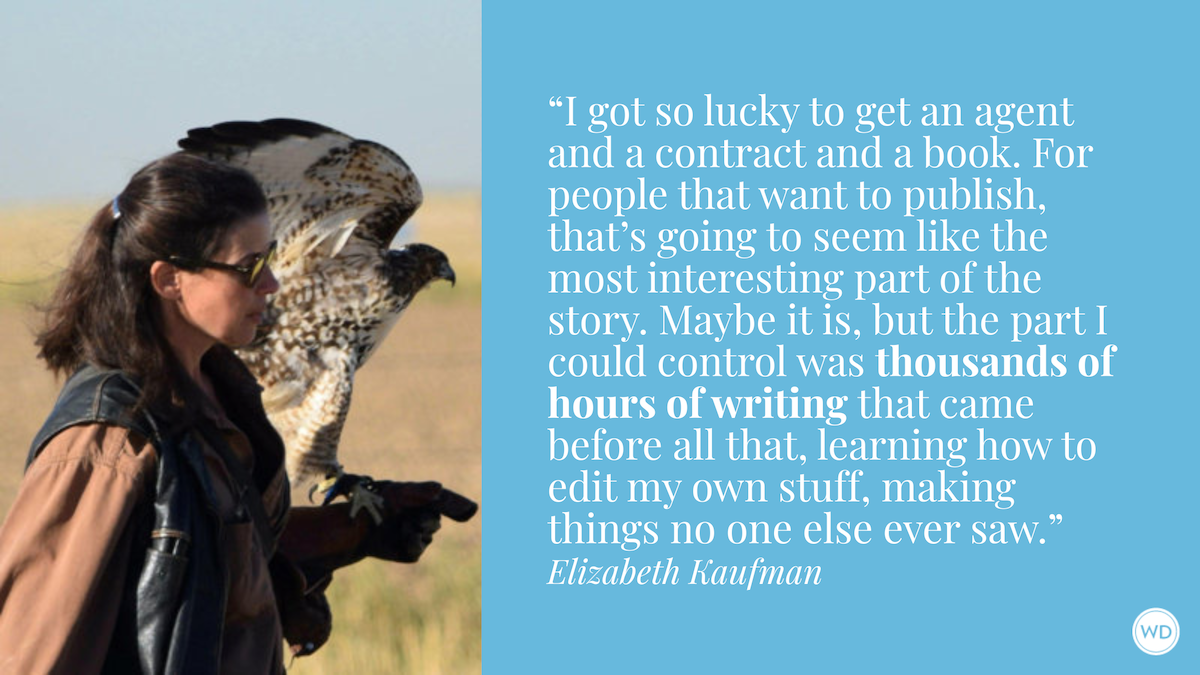Death Riding Shotgun: How Awareness of Mortality Can Animate Writing
Author Lisa C. Taylor discusses how the awareness of our mortality can animate our writing and improve our lives.
Writing about death and grief is a form of love. Whether your character lost a child (as in my just released novel, The Shape of What Remains) or a loved one, life cannot continue as it was before the loss. It’s up to you to tell this most human of stories: our ongoing relationship to mortality.
We know that we will all die at some point, but it is a universal truth that many avoid talking about or writing about death. As writers, we know how to go into dark places. We also know that processing grief involves facing our own mortality and the mortality of those we love. Pull out the Moleskine in your pocket or bag or your computer and explore your own feelings about death as it relates to your stories or poems.
Literature has long helped readers understand human desires and frailties. Two elderly people holding hands over their wheelchairs in the hallway of the convalescent home have a story. One of them will die first. Perhaps they are both widowed and recently met after losing their longtime partners. A teen driver running a light at a busy intersection and just missing a head-on collision has a story. Maybe she will become a better driver because that incident will be a moment where she literally faced her own mortality. There are illnesses and accidents, the tenderness and tedium of caretaking. These are stories that often don’t get told.
Lighten up, I can hear people saying. Is it the role of writing to talk around the inevitability of death? How else can writers guide readers who have experienced loss? There is something healing about reading a story where characters once again see vivid reds and greens emerge in spring after too many seasons of drab or muted colors. After loss, the world can seem diminished. Stories can recount the long trek back, aided by friends, family members, or therapists.
Every culture, every person, every time period has stories about loss. Stories help us grapple with our own mortality and the mortality of those we love. Some stories make us indignant, angry, or hopeful. Reading stories or poems with a theme of loss or grief helps to mitigate the pain because we do not feel as alone.
Let your characters express themselves in a realistic and compelling way. Do not shy away from death. Stories can surprise us, horrify us, or lead us to contemplate. When you are immersed in the author’s fictional world, the emotional connection is real even though the story is fiction. Bits of real life turn up regularly in poetry and prose—a parking ticket, an overheard conversation, a dead pet. Once I saw a dress discarded on the path while walking behind my house. What kind of story might that be?
Some writers use the material of their lives to heal and move on after trauma. Tim O'Brien wrote about the Vietnam War in his 1990 book, The Things They Carried, a collection of linked stories, and Kristin Hannah wrote a fictionalized account about the forgotten nurses of Vietnam in her recent novel, The Women. Joan Didion wrote about the magnitude of loss she felt after her husband’s sudden death in her book, The Year of Magical Thinking. Language can represent trauma and transform it into art. I think of the gorgeous and spare writing of Claire Keegan in Small Things Like These, a story about moral conundrums and rising to be our best self when a character is witness to unexpected horror.
In 2018 I shared a house in Ireland with various writers and artists. One was a young dancer. She related a story about washing her mother's blouse when she knew her mother was dying. She wept on the floor by the washing machine when it became clear that her mother would never again wear this blouse—and then she made art of the loss by creating a dance that incorporated the washing of the blouse and the grief it represented. All of us can use life experiences to make something beautiful.
Suffering and joy are distinctly human experiences and writing is another way of processing incalculable loss. It need not be your story. Ideas come from everywhere. A sad-eyed server at a fictional restaurant may have a secret that you write about in a way that evokes emotion. Get in the habit of paying attention. Be unafraid to use your own emotional experiences in your writing. Emotional truth is not the same as literal truth. In fiction, you can change names, demographics, and even circumstances but the feelings are universal.
During the pandemic, many of us became more aware of our mortality as life as we knew it ground to a halt. Uncertainty and fear became regular visitors. Some of us used this to make art and some of us were directly impacted when we lost loved ones. The scenes from the pandemic included nursing home visits through a window, Facetime or Zoom goodbyes to dying family members, paranoia about groceries, shared air, and all modes of public transportation. Most of us felt as if death was closer than ever, even if we were young. Schoolchildren and parents had to learn or work remotely. What lessons did we learn during that time and how can we use that urgency in our writing?
Stories or poems about mortality are also stories and poems about living fully. They remind us that we are fragile and our presence on this planet is temporary. While that may seem depressing, it also enables to live and write with a sense of how vital and important every moment can be in this complicated world. Look at the shadows the sun makes on asphalt or a cloud formations before a storm. Awareness of the finite time you have here on makes your writing life vital. Do not squander it.
Check out Lisa C. Taylor's The Shape of What Remains here:
(WD uses affiliate links)
Lisa C. Taylor’s first novel, The Shape of What Remains releases with Liminal Books on February 18, 2025. Her previous publications include the poetry collection, Interrogation of Morning (2022), the short story collection, Impossibly Small Spaces released by Arlen House/Syracuse University Press in 2018, the short story collection, Growing a New Tail, and two additional poetry collections, Necessary Silence (2013) and The Other Side of Longing (2011), a collaborative collection with Irish poet and writer Geraldine Mills. She also has two poetry chapbooks. Taylor’s poetry, fiction, and nonfiction has been widely published in national and international journals, magazines, and anthologies. Nominated for the Pushcart Prize in both fiction and poetry, she also garnered Best-of-the-Net nominations in both categories. Lisa won the Hugo House New Works Fiction Award in 2015 and was a spotlight feature on the Associated Writing Programs (AWP) web site and a two-time mentor in their writer-to-writer program. Taylor holds an MFA in Creative Writing from Stonecoast at The University of Southern Maine, teaches online and facilitates workshops around the country at writers’ conferences and schools and is the co-director of the Mesa Verde Writers Conference and Literary Festival.








